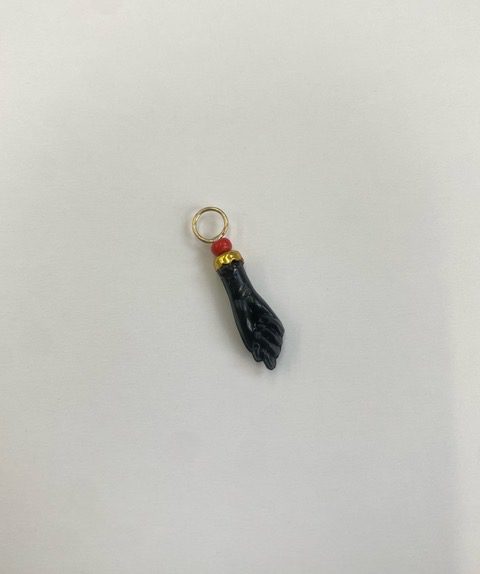Edward Tabor
Bethesda, Maryland, United States

In my pediatric residency at a New York City hospital many years ago, I noticed that half of my Hispanic infant patients, as well as some toddlers, wore a small black and red amulet that their parents hoped would protect against disease. When I asked other residents and attending physicians about it, none of them seemed to know anything about it. I became curious about the origin of this amulet, but I was not able to find it out until recently.
As a resident, I began asking the parents of my patients about the amulet while I began each physical examination. It was an excellent conversation opener; the parents seemed to relax when they talked about it. I kept records of many of those conversations.
They told me that the amulet is called an azabache. It is worn to guard against “the evil eye” (“mal de ojo”) and prevent conditions such as diarrhea, respiratory infections, deformities, and, particularly, sudden infant death. As one mother explained it, “Of course it works. He’s never been sick before this.”
The word “azabache” is Spanish for “jet,” a minor gemstone that is one of the substances used to make the amulet. It was worn either on a gold chain on the wrist or occasionally pinned to the undershirt over the left breast with a small safety pin. It came in two forms. The first was a small black fist about 8 mm in length, often with a small red bead on the proximal end; in most cases, the thumb of the fist was tucked under the forefinger. The second form was a black polyhedron about 3 to 4 mm in diameter, paired with a small red bead. Among those who wore it, 29% wore the fist and 71% wore the polyhedron. The parents maintained there was no difference in significance between the two forms.
It was purchased for the baby by the parents, grandparents, or other relatives, but the parents told me that it was always purchased after the birth of the baby. At that time, an azabache cost between $3 to $10 in folk medicine stores called botanicas. Today, an azabache can be bought on the internet for between $9 to $55 (without the chain). In my clinic, 40% of babies with an azabache also wore a Virgin Mary medallion.
I wondered about the source of this tradition. Most of these patients lived in neighborhoods where the culture of Puerto Rico was dominant. The culture of Puerto Rico is derived from several converging cultures: Spanish, West African, and Native American (mostly Taino) peoples. A few of these infants wearing the azabache were in families from Cuba or the Dominican Republic, islands that also had been populated by the Taino people before colonization by Spain. In addition to Taino ancestry and colonization by Spain, all three islands had in common an influx of enslaved people brought by the Spanish from sub-Saharan Africa. The black fist made me think the tradition perhaps could have had West African origins.
However, I recently found a short story by Washington Irving (1783–1859) that suggests the amulet probably originated in the Muslim cultures of North Africa. The Moors of North Africa, consisting of Berbers and Arabs, ruled Spain for almost 800 years, from 711 to 1492 AD. Washington Irving’s “Legend of the Two Discreet Statues,”1 a ghostly tale of hidden treasure buried by the Moors in Spain, tells the origin of a similar amulet:
[A young Spanish girl] Sanchica with some of her playmates sported among the ruins of an old Moorish fort that crowns the mountain, when, in gathering pebbles in the fosse, she found a small hand curiously carved of jet, the fingers closed, and the thumb firmly clasped upon them. … an old tawny soldier drew near, who had served in Africa, and was as swarthy as a Moor. He examined the hand with a knowing look. “I have seen things of this kind,” said he, “among the Moors of Barbary. It is a great virtue to guard against the evil eye and all kinds of spells and enchantments.” … [Her mother] tied the little hand of jet to a ribbon, and hung it round the neck of her daughter.
For three months in 1829, Irving lived in an apartment inside the Alhambra, a Moorish palace in Granada, Spain, whose governor he had befriended. Here, he had access to the palace’s staff and archives. He filled his journals with stories and legends about the Moors,2 which he published in 1832 in Tales of the Alhambra.3 The story indicates that the tradition of the amulet was brought to Spain from the Muslim peoples of North Africa, and one can assume that from Spain it was brought to the Caribbean colonies.
The world is full of risks, and disease is one of the greatest of these. The azabache was placed on an infant to counteract those risks, and it provided the family a sense of control. Today, the existence of numerous websites selling the azabache shows that these beliefs continue.
References
- Irving W. “Legend of the Two Discreet Statues,” in Tales of the Alhambra, Miguel Sanchez, Granada, 1973, pages 267-284.
- Jones B.J. Washington Irving: An American Original, Arcade Publishing, New York, 2008, pages 251, 260.
- Irving W. Tales of the Alhambra. Miguel Sanchez, Granada, 1973.
EDWARD TABOR, M.D. has worked at the US Food and Drug Administration, the National Cancer Institute (NIH), and Fresenius Kabi. He has published widely on viral hepatitis, liver cancer, and pharmaceutical regulatory affairs.

Leave a Reply